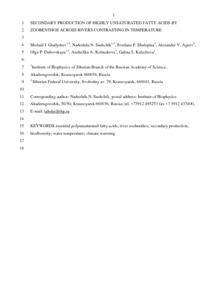Secondary production of highly unsaturated fatty acids by zoobenthos across rivers contrasting in temperature
Скачать файл:
DOI:
10.1002/rra.2945URI (для ссылок/цитирований):
https://elib.sfu-kras.ru/handle/2311/27915Автор:
Gladyshev, M. I.
Sushchik, N. N.
Shulepina, S. P.
Ageev, A. V.
Dubovskaya, O. P.
Kolmakova, A. A.
Kalachova, G. S.
Коллективный автор:
Институт фундаментальной биологии и биотехнологии
Кафедра водных и наземных экосистем
Дата:
2016-07Журнал:
River Research and ApplicationsКвартиль журнала в Scopus:
Q1Квартиль журнала в Web of Science:
Q2Библиографическое описание:
Gladyshev, M. I. Secondary production of highly unsaturated fatty acids by zoobenthos across rivers contrasting in temperature [Текст] / M. I. Gladyshev, N. N. Sushchik, S. P. Shulepina, A. V. Ageev, O. P. Dubovskaya, A. A. Kolmakova, G. S. Kalachova // River Research and Applications. — 2016. — Т. 32 (№ 6). — С. 1252-1263Аннотация:
Highly unsaturated fatty acids (HUFA), namely eicosapentaenoic acid (20:5n-3, EPA) and docosahexaenoic acid (22:6n-3, DHA), which are essential for many animals, including humans, are mainly produced in aquatic trophic webs. In fast-flowing rivers, macrozoobenthos is the main source of HUFA for fish and may be particularly vulnerable to thermal alterations associated with climate change. We studied benthic communities in a unique natural ecosystem: the Yenisei River downstream of the dam of Krasnoyarsk Hydroelectric Power Station with very low temperature in summer because of discharge of cold water from deep in the reservoir and its tributaries with high summer temperature. This ‘natural experiment’ allowed to get rid of confounding factors, such as differences in light, seasonality, geology (biogeochemistry) and biogeography (regional species pools). As found, in spite of an increase of biodiversity and rates of daily production in warm rivers compared with cold sites, DHA and partly EPA production of zoobenthos decreased with the increase of temperature because of changes in species composition. Thus, in a climate warming context, we can predict a decrease of production of these HUFA by river zoobenthos and thereby a diminishing of their supply for fish and next to humans.

